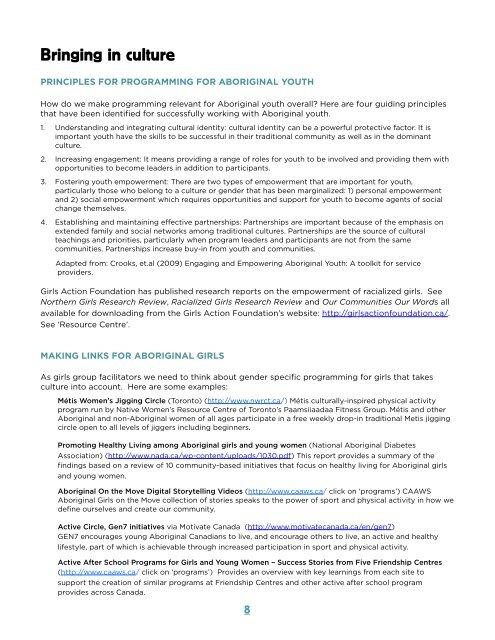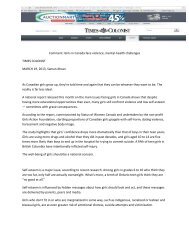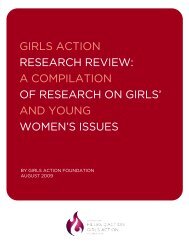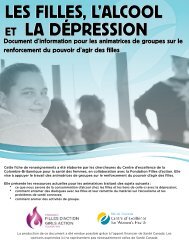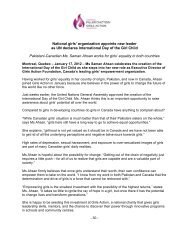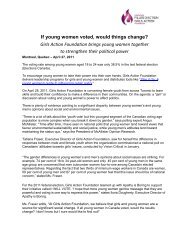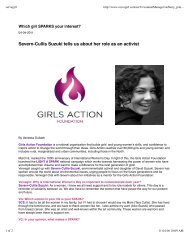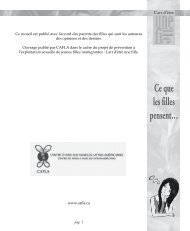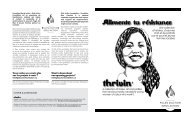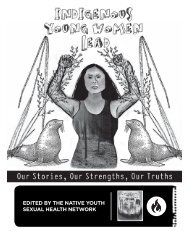physical activity - Girls Action Foundation
physical activity - Girls Action Foundation
physical activity - Girls Action Foundation
You also want an ePaper? Increase the reach of your titles
YUMPU automatically turns print PDFs into web optimized ePapers that Google loves.
Bringing in culture<br />
PRINCIPLES FOR PROGRAMMING FOR ABORIGINAL YOUTH<br />
How do we make programming relevant for Aboriginal youth overall? Here are four guiding principles<br />
that have been identified for successfully working with Aboriginal youth.<br />
1. Understanding and integrating cultural identity: cultural identity can be a powerful protective factor. It is<br />
important youth have the skills to be successful in their traditional community as well as in the dominant<br />
culture.<br />
2. Increasing engagement: It means providing a range of roles for youth to be involved and providing them with<br />
opportunities to become leaders in addition to participants.<br />
3. Fostering youth empowerment: There are two types of empowerment that are important for youth,<br />
particularly those who belong to a culture or gender that has been marginalized: 1) personal empowerment<br />
and 2) social empowerment which requires opportunities and support for youth to become agents of social<br />
change themselves.<br />
4. Establishing and maintaining effective partnerships: Partnerships are important because of the emphasis on<br />
extended family and social networks among traditional cultures. Partnerships are the source of cultural<br />
teachings and priorities, particularly when program leaders and participants are not from the same<br />
communities. Partnerships increase buy-in from youth and communities.<br />
Adapted from: Crooks, et.al (2009) Engaging and Empowering Aboriginal Youth: A toolkit for service<br />
providers.<br />
<strong>Girls</strong> <strong>Action</strong> <strong>Foundation</strong> has published research reports on the empowerment of racialized girls. See<br />
Northern <strong>Girls</strong> Research Review, Racialized <strong>Girls</strong> Research Review and Our Communities Our Words all<br />
available for downloading from the <strong>Girls</strong> <strong>Action</strong> <strong>Foundation</strong>’s website: http://girlsactionfoundation.ca/.<br />
See ‘Resource Centre’.<br />
MAKING LINKS FOR ABORIGINAL GIRLS<br />
As girls group facilitators we need to think about gender specific programming for girls that takes<br />
culture into account. Here are some examples:<br />
Métis Women’s Jigging Circle (Toronto) (http://www.nwrct.ca/) Métis culturally-inspired <strong>physical</strong> <strong>activity</strong><br />
program run by Native Women’s Resource Centre of Toronto’s Paamsiiaadaa Fitness Group. Métis and other<br />
Aboriginal and non-Aboriginal women of all ages participate in a free weekly drop-in traditional Metis jigging<br />
circle open to all levels of jiggers including beginners.<br />
Promoting Healthy Living among Aboriginal girls and young women (National Aboriginal Diabetes<br />
Association) (http://www.nada.ca/wp-content/uploads/1030.pdf) This report provides a summary of the<br />
findings based on a review of 10 community-based initiatives that focus on healthy living for Aboriginal girls<br />
and young women.<br />
Aboriginal On the Move Digital Storytelling Videos (http://www.caaws.ca/ click on ‘programs’) CAAWS<br />
Aboriginal <strong>Girls</strong> on the Move collection of stories speaks to the power of sport and <strong>physical</strong> <strong>activity</strong> in how we<br />
define ourselves and create our community.<br />
Active Circle, Gen7 initiatives via Motivate Canada (http://www.motivatecanada.ca/en/gen7)<br />
GEN7 encourages young Aboriginal Canadians to live, and encourage others to live, an active and healthy<br />
lifestyle, part of which is achievable through increased participation in sport and <strong>physical</strong> <strong>activity</strong>.<br />
Active After School Programs for <strong>Girls</strong> and Young Women – Success Stories from Five Friendship Centres<br />
(http://www.caaws.ca/ click on ‘programs’) Provides an overview with key learnings from each site to<br />
support the creation of similar programs at Friendship Centres and other active after school program<br />
provides across Canada.<br />
8


